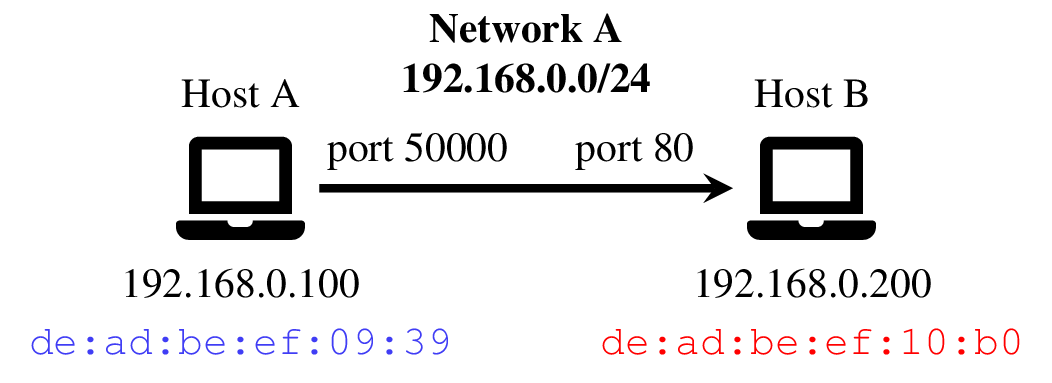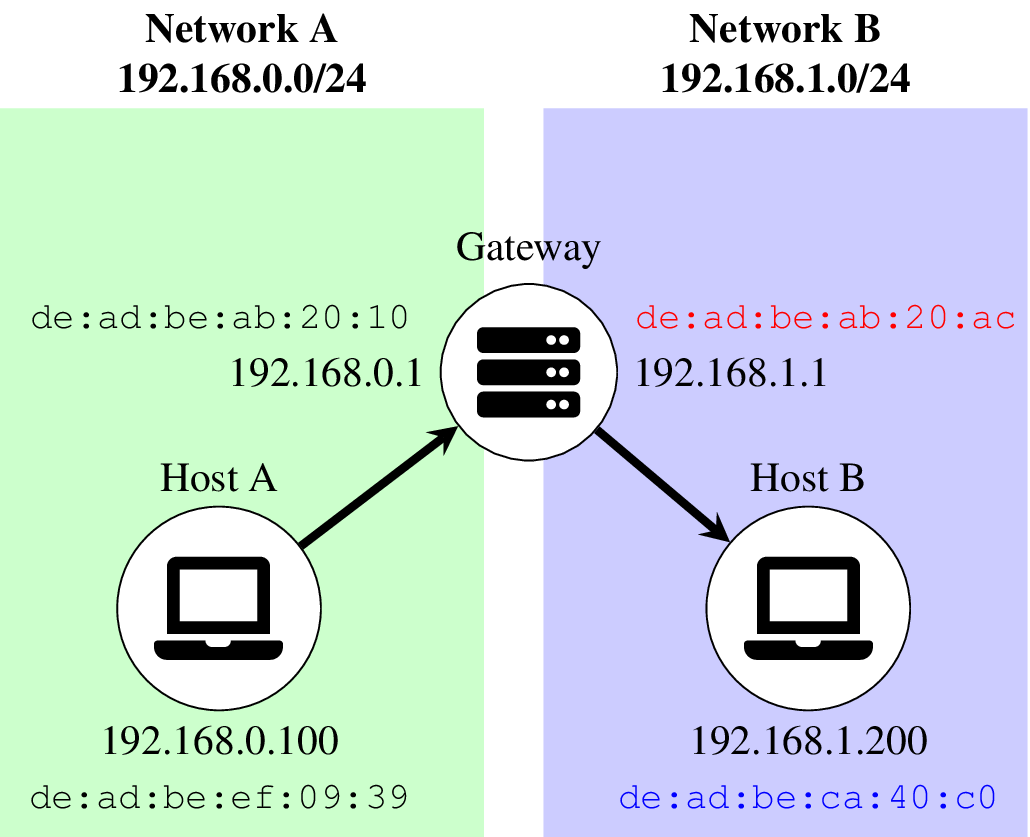Unicasts
Unicasts are point-to-point transmissions. The following are two examples of how TCP/IP packets travel through a network.
How a TCP/IP Packet moves within a local network

Let’s look at a simple example of a network packet being transmitted within one network:
IP Address |
Subnet Mask |
|
|---|---|---|
Network A |
192.168.0.0 |
255.255.255.0 |
Inside of this network we have two hosts with the following IP and MAC addresses:
IP Address |
MAC Address |
|
|---|---|---|
Host A |
192.168.0.100 |
de:ad:be:ef:09:39 |
Host B |
192.168.0.200 |
de:ad:be:ef:10:b0 |
We want to send a TCP segments as IP packet from Host A to Host B. The IP packet will look as follows:
IP Packet |
|
Source IP |
192.168.0.100 |
Destination IP |
192.168.0.200 |
TCP Segment |
|
Given the network configuration, Host A can determine that the destination IP
address is within the same subnet of its own IP address. Its IP address is
associated to a network device with the MAC address de:ad:be:ef:09:39.
Using the ARP protocol, Host A will ask for the MAC address for the destination
IP 192.168.0.200. Host B will answer with its own MAC address
de:ad:be:ef:10:b0. Using this information, the IP packet can now put into
an Ethernet frame and send over the network interface.
Ethernet Frame |
|
|---|---|
Source MAC |
de:ad:be:ef:09:39 |
Destination MAC |
de:ad:be:ef:10:b0 |
IP Packet |
|
Source IP |
192.168.0.100 |
Destination IP |
192.168.0.200 |
TCP Segment |
|
How a TCP/IP Packet moves to an external network
Now, what happens if an IP packet is sent to a system in a different network?
Here is a configuration with two networks. A gateway/router is connected to
both networks and is assigned a network IP address in each of them. The network
interface connected to network A has the MAC address de:ad:be:ab:20:10,
while the other network interface connected to network B has the MAC address
de:ad:be:ab:20:ac

IP Address |
Subnet Mask |
Gateway |
Gateway MAC |
|
|---|---|---|---|---|
Network A |
192.168.0.0 |
255.255.255.0 |
192.168.0.1 |
de:ad:be:ab:20:10 |
Network B |
192.168.1.0 |
255.255.255.0 |
192.168.1.1 |
de:ad:be:ab:20:ac |
IP Address |
MAC Address |
|
|---|---|---|
Host A |
192.168.0.100 |
de:ad:be:ef:09:39 |
Host B |
192.168.1.200 |
de:ad:be:ca:40:c0 |
IP Packet |
|
Source IP |
192.168.0.100 |
Destination IP |
192.168.1.200 |
TCP Segment |
|
An IP Packet that is addressed to a destination outside of the IP subnet Host A is connected to will instead be transmitted to the gateway of that network. During this transmission the ARP protocol is used to determine the MAC address of the gateway IP address.
Ethernet Frame |
|
|---|---|
Source MAC |
de:ad:be:ef:09:39 |
Destination MAC |
de:ad:be:ab:20:10 |
IP Packet |
|
Source IP |
192.168.0.100 |
Destination IP |
192.168.1.200 |
TCP Segment |
|
The gateway/router can then choose what to do with such a packet. If the necessary routing and firewall rules are configured, the gateway will unpack the Ethernet frame, and then retransmit the IP package. In this case, the gateway is connected to two networks.
Based on the destination IP address of the packet, the gateway can determine that it must be forwarded to network B. Since the IP address is within the subnet of network B, the gateway can determine the target MAC address via ARP. The gateway will then repackage the IP packet in a new Ethernet frame addressed to this target MAC.
Ethernet Frame |
|
|---|---|
Source MAC |
de:ad:be:ef:09:39 |
Destination MAC |
de:ad:be:ca:40:c0 |
IP Packet |
|
Source IP |
192.168.0.100 |
Destination IP |
192.168.1.200 |
TCP Segment |
|